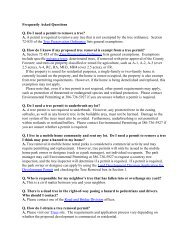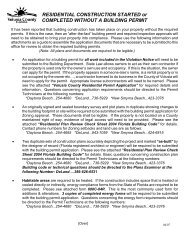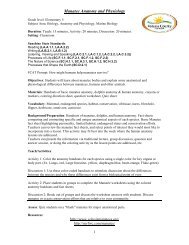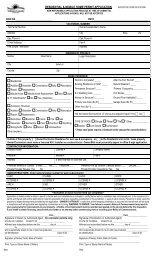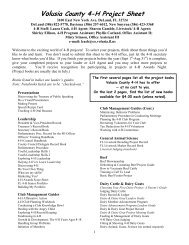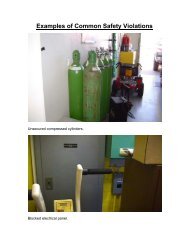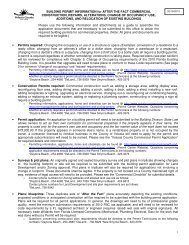- Page 1:
VOLUSIA COUNTY, FLORIDAMULTI-JURISD
- Page 5 and 6:
SECTION 1: INTRODUCTION1.2 PURPOSET
- Page 7 and 8:
SECTION 1: INTRODUCTIONand land use
- Page 9 and 10:
SECTION 2: PLANNING PROCESSSECTION
- Page 11 and 12:
SECTION 2: PLANNING PROCESSPlan Out
- Page 13 and 14:
SECTION 2: PLANNING PROCESSHelp com
- Page 15 and 16:
SECTION 2: PLANNING PROCESSDiscussi
- Page 17 and 18:
SECTION 3: COMMUNITY PROFILESECTION
- Page 19 and 20:
SECTION 3: COMMUNITY PROFILETABLE 3
- Page 21 and 22:
SECTION 3: COMMUNITY PROFILE3.3 HOU
- Page 23 and 24:
SECTION 3: COMMUNITY PROFILEIn 2007
- Page 25 and 26:
SECTION 4: HAZARD IDENTIFICATIONTAB
- Page 27 and 28:
SECTION 4: HAZARD IDENTIFICATIONTAB
- Page 29 and 30:
SECTION 5: HAZARD PROFILESMajor Dis
- Page 31 and 32:
SECTION 5: HAZARD PROFILESTABLE 5.2
- Page 33 and 34:
SECTION 5: HAZARD PROFILESTABLE 5.3
- Page 35 and 36:
SECTION 5: HAZARD PROFILESTABLE 5.3
- Page 37 and 38:
SECTION 5: HAZARD PROFILES5.3 HURRI
- Page 39 and 40:
SECTION 5: HAZARD PROFILES5.3.2 Loc
- Page 41 and 42:
SECTION 5: HAZARD PROFILESFIGURE 5.
- Page 43 and 44:
SECTION 5: HAZARD PROFILESHurricane
- Page 45 and 46:
SECTION 5: HAZARD PROFILESTABLE 5.7
- Page 47 and 48:
SECTION 5: HAZARD PROFILES5.4.2 Loc
- Page 49 and 50:
SECTION 5: HAZARD PROFILES5.4.4 Pro
- Page 51 and 52:
SECTION 5: HAZARD PROFILESto late 8
- Page 53 and 54:
SECTION 5: HAZARD PROFILESFigure 5.
- Page 55 and 56:
SECTION 5: HAZARD PROFILESTABLE 5.9
- Page 57 and 58:
SECTION 5: HAZARD PROFILESTABLE 5.9
- Page 59 and 60:
SECTION 5: HAZARD PROFILESTABLE 5.1
- Page 61 and 62:
SECTION 5: HAZARD PROFILESFIGURE 5.
- Page 63 and 64:
SECTION 5: HAZARD PROFILESTABLE 5.1
- Page 65 and 66:
SECTION 5: HAZARD PROFILESTABLE 5.1
- Page 67 and 68:
SECTION 5: HAZARD PROFILESFIGURE 5.
- Page 69 and 70:
SECTION 5: HAZARD PROFILES5.8.3 His
- Page 71 and 72:
SECTION 5: HAZARD PROFILES5.9 DROUG
- Page 73 and 74:
SECTION 5: HAZARD PROFILESwas expan
- Page 75 and 76:
SECTION 5: HAZARD PROFILESexpected
- Page 77 and 78:
SECTION 5: HAZARD PROFILESTABLE 5.1
- Page 79 and 80:
SECTION 5: HAZARD PROFILESTABLE 5.1
- Page 81 and 82:
SECTION 5: HAZARD PROFILES5.11 STOR
- Page 83 and 84:
SECTION 5: HAZARD PROFILESGEOLOGIC
- Page 85 and 86:
SECTION 5: HAZARD PROFILESTABLE 5.1
- Page 87 and 88:
SECTION 5: HAZARD PROFILESTABLE 5.1
- Page 89 and 90: SECTION 5: HAZARD PROFILES5.13 TSUN
- Page 91 and 92: SECTION 5: HAZARD PROFILESthe entir
- Page 93 and 94: SECTION 5: HAZARD PROFILESsystem to
- Page 95 and 96: SECTION 5: HAZARD PROFILES5.15 CONC
- Page 97 and 98: SECTION 5: HAZARD PROFILESvarying o
- Page 99 and 100: SECTION 6: VULNERABILITY ASSESSMENT
- Page 101 and 102: SECTION 6: VULNERABILITY ASSESSMENT
- Page 103 and 104: SECTION 6: VULNERABILITY ASSESSMENT
- Page 105 and 106: SECTION 6: VULNERABILITY ASSESSMENT
- Page 107 and 108: SECTION 6: VULNERABILITY ASSESSMENT
- Page 109 and 110: SECTION 6: VULNERABILITY ASSESSMENT
- Page 111 and 112: SECTION 6: VULNERABILITY ASSESSMENT
- Page 113 and 114: SECTION 6: VULNERABILITY ASSESSMENT
- Page 115 and 116: SECTION 6: VULNERABILITY ASSESSMENT
- Page 117 and 118: SECTION 6: VULNERABILITY ASSESSMENT
- Page 119 and 120: SECTION 6: VULNERABILITY ASSESSMENT
- Page 121 and 122: SECTION 6: VULNERABILITY ASSESSMENT
- Page 123 and 124: SECTION 6: VULNERABILITY ASSESSMENT
- Page 125 and 126: SECTION 6: VULNERABILITY ASSESSMENT
- Page 127 and 128: SECTION 6: VULNERABILITY ASSESSMENT
- Page 129 and 130: SECTION 6: VULNERABILITY ASSESSMENT
- Page 131 and 132: SECTION 6: VULNERABILITY ASSESSMENT
- Page 133 and 134: SECTION 6: VULNERABILITY ASSESSMENT
- Page 135 and 136: SECTION 7: CAPABILITY ASSESSMENTapp
- Page 137 and 138: SECTION 7: CAPABILITY ASSESSMENT7.3
- Page 139: SECTION 7: CAPABILITY ASSESSMENTfut
- Page 143 and 144: SECTION 7: CAPABILITY ASSESSMENTTAB
- Page 145 and 146: SECTION 7: CAPABILITY ASSESSMENTmus
- Page 147 and 148: SECTION 8: MITIGATION STRATEGYThe s
- Page 149 and 150: SECTION 8: MITIGATION STRATEGY8.2 M
- Page 151 and 152: SECTION 8: MITIGATION STRATEGYObjec
- Page 153 and 154: SECTION 8: MITIGATION STRATEGYObjec
- Page 155 and 156: SECTION 8: MITIGATION STRATEGY Capi
- Page 157 and 158: SECTION 8: MITIGATION STRATEGYTABLE
- Page 159 and 160: SECTION 8: MITIGATION STRATEGYhave
- Page 161 and 162: SECTION 9: MITIGATION ACTION PLANTa
- Page 163 and 164: SECTION 9: MITIGATION ACTION PLANIn
- Page 165 and 166: SECTION 9: MITIGATION ACTION PLAN7.
- Page 167 and 168: PriorityHazard(s)MitigationTechniqu
- Page 169 and 170: PriorityHazard(s)MitigationTechniqu
- Page 171 and 172: PriorityHazard(s)MitigationTechniqu
- Page 173 and 174: PriorityHazard(s)MitigationTechniqu
- Page 175 and 176: PriorityHazard(s)MitigationTechniqu
- Page 177 and 178: PriorityHazard(s)MitigationTechniqu
- Page 179 and 180: SECTION 10: PLAN MAINTENANCE PROCED
- Page 181 and 182: SECTION 10: PLAN MAINTENANCE PROCED
- Page 183 and 184: SECTION 10: PLAN MAINTENANCE PROCED
- Page 185 and 186: APPENDIX B: BYLAWS AND OPERATING PR
- Page 187 and 188: Article IV. ObjectivesThe objective
- Page 189 and 190: B. Meetings, Voting and Quorum1. Me
- Page 191 and 192:
• Periodic review of the status o
- Page 193 and 194:
In its discretion, the LMS Working
- Page 195 and 196:
This analysis may be conducted by t
- Page 197 and 198:
• The participants proposing the
- Page 199 and 200:
• The currently approved listing
- Page 201 and 202:
LMS Working Group, with the support
- Page 203 and 204:
Volusia PreparesTHE VOLUSIA COUNTY
- Page 205 and 206:
Volusia County Local Mitigation Str
- Page 207:
jurisdictions, the Florida Division
- Page 211 and 212:
file://C:\Documents and Settings\18
- Page 213 and 214:
Volusia County Local Mitigation Str
- Page 217 and 218:
Aug. 17, 2009Contact: Shelley Szafr
- Page 219:
Volusia County Local Mitigation Str
- Page 224 and 225:
APPENDIX F: INDIVIDUAL JURISDICTION
- Page 226 and 227:
PriorityHazard(s)Mitigation Techniq
- Page 228 and 229:
APPENDIX F: INDIVIDUAL JURISDICTION
- Page 230 and 231:
APPENDIX F: INDIVIDUAL JURISDICTION
- Page 232 and 233:
APPENDIX F: INDIVIDUAL JURISDICTION
- Page 234 and 235:
APPENDIX F: INDIVIDUAL JURISDICTION
- Page 236 and 237:
PriorityHazard(s)MitigationTechniqu
- Page 238 and 239:
APPENDIX F: INDIVIDUAL JURISDICTION
- Page 240 and 241:
PriorityHazard(s)MitigationTechniqu
- Page 242 and 243:
PriorityHazard(s)MitigationTechniqu
- Page 244 and 245:
APPENDIX F: INDIVIDUAL JURISDICTION
- Page 246 and 247:
APPENDIX F: INDIVIDUAL JURISDICTION
- Page 248 and 249:
PriorityHazard(s)MitigationTechniqu
- Page 250 and 251:
APPENDIX F: INDIVIDUAL JURISDICTION
- Page 252 and 253:
APPENDIX F: INDIVIDUAL JURISDICTION
- Page 254 and 255:
APPENDIX F: INDIVIDUAL JURISDICTION
- Page 256 and 257:
PriorityHazard(s)MitigationTechniqu
- Page 258 and 259:
PriorityHazard(s)MitigationTechniqu
- Page 260 and 261:
PriorityHazard(s)MitigationTechniqu
- Page 262 and 263:
PriorityHazard(s)MitigationTechniqu
- Page 264 and 265:
PriorityHazard(s)MitigationTechniqu
- Page 266 and 267:
APPENDIX F: INDIVIDUAL JURISDICTION
- Page 268 and 269:
PriorityHazard(s)MitigationTechniqu
- Page 270 and 271:
PriorityHazard(s)MitigationTechniqu
- Page 272 and 273:
PriorityHazard(s)MitigationTechniqu
- Page 274 and 275:
PriorityHazard(s)MitigationTechniqu
- Page 276 and 277:
PriorityHazard(s)MitigationTechniqu
- Page 278 and 279:
PriorityHazard(s)MitigationTechniqu
- Page 280:
PriorityHazard(s)MitigationTechniqu



